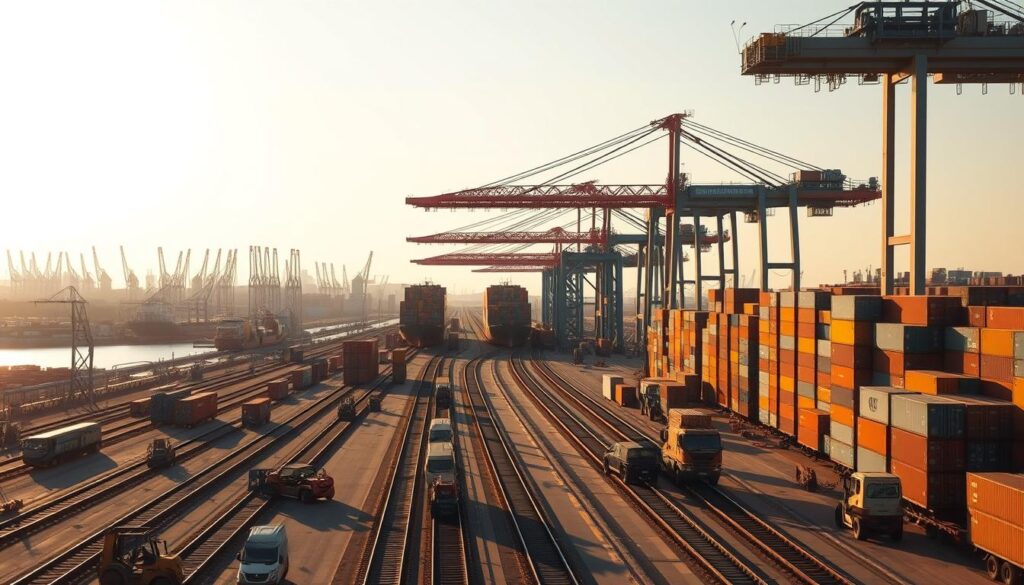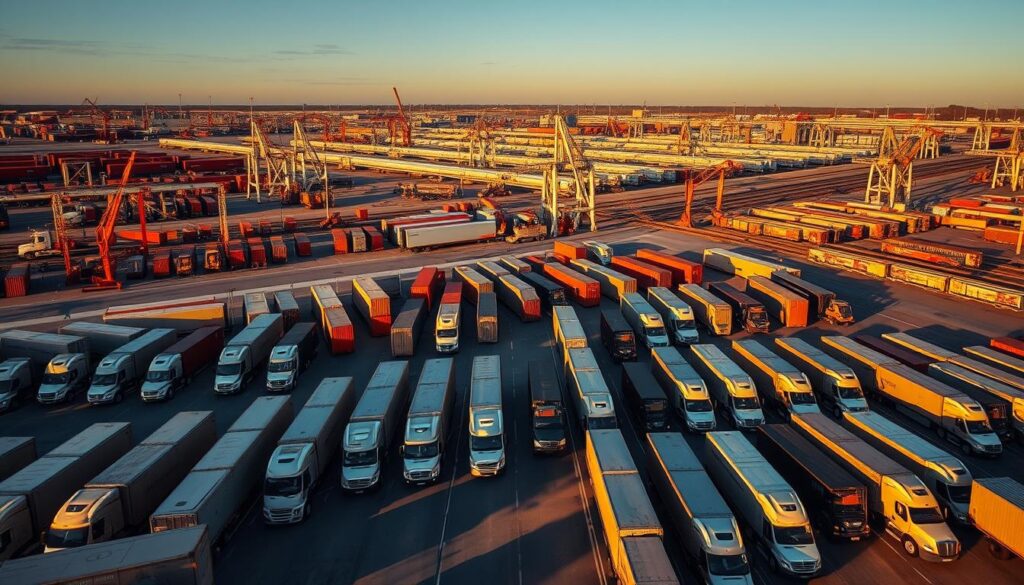Can efficient logistics and supply chain management be the key to unlocking a more prosperous global commerce?
In today’s interconnected world, the importance of streamlined logistics cannot be overstated. Efficient transportation systems play a crucial role in the Supply Chain & Transportation Career Cluster, driving economic development and community health.
The concept of freight transport engineering is at the forefront of this endeavor, focusing on optimizing the flow of goods and services. By leveraging logistics engineering services, businesses can significantly enhance their supply chain operations.
Key Takeaways
- Efficient logistics are crucial for global commerce and economic development.
- Freight transport engineering optimizes the flow of goods and services.
- Logistics engineering services enhance supply chain operations.
- Streamlined supply chains drive business prosperity.
- Efficient transportation systems are vital for community health.
Understanding Freight Transport Engineering
As global trade continues to expand, the importance of freight transport engineering in streamlining logistics cannot be overstated. Freight transport engineering is a multifaceted field that involves the application of engineering principles to improve the efficiency and effectiveness of freight transportation systems.
Definition and Scope
Freight transport engineering encompasses a broad range of activities, including the planning, design, and operation of transportation systems. It involves the strategic management of supply chain activities to maximize efficiency and reduce costs. The scope of freight transport engineering is vast, covering various modes of transportation such as road, rail, air, and sea.
Key aspects of freight transport engineering include:
- Optimizing transportation routes and networks
- Improving the efficiency of logistics operations
- Implementing advanced technologies for tracking and monitoring
- Enhancing supply chain resilience and reliability
Importance in Modern Logistics
Freight transport engineering plays a crucial role in modern logistics by enabling businesses to move goods efficiently and cost-effectively. Effective freight transport engineering solutions can lead to significant improvements in supply chain performance, including reduced transit times, lower transportation costs, and improved customer satisfaction.
The importance of freight transport engineering is highlighted in the following table, which compares the benefits of optimized freight transport systems:
| Benefits | Traditional Systems | Optimized Systems |
|---|---|---|
| Transit Time | Longer transit times due to inefficiencies | Reduced transit times through optimized routing |
| Cost | Higher costs due to fuel inefficiency and labor costs | Lower costs through improved fuel efficiency and reduced labor costs |
| Reliability | Lower reliability due to potential delays and disruptions | Improved reliability through advanced tracking and monitoring systems |
By understanding the principles and practices of freight transport engineering, businesses can leverage transportation logistics and freight optimization solutions to enhance their supply chain operations and stay competitive in the global market.
Key Components of Freight Transport Engineering
At the heart of freight transport engineering lie three critical elements: infrastructure development, transportation modes, and technological integration, all of which play a vital role in shaping modern logistics.
The development of robust infrastructure is fundamental to the efficiency of freight transport. This includes not just the physical structures like roads, bridges, and tunnels, but also the shipping infrastructure design that facilitates the smooth movement of goods. A well-designed infrastructure can significantly reduce transit times and costs, thereby enhancing the overall competitiveness of the logistics industry.
Infrastructure Development
Infrastructure development is a cornerstone of freight transport engineering. It involves the construction and maintenance of transportation networks that are capable of handling large volumes of cargo efficiently. For instance, the development of dedicated freight corridors can help in reducing congestion on highways and improving the overall transit time. Moreover, investments in infrastructure can also lead to better connectivity between different regions, thereby opening up new markets and opportunities for businesses.

Transportation Modes
The choice of transportation mode is another critical aspect of freight transport engineering. Different modes, such as road, rail, air, and maritime, offer varying advantages in terms of cost, speed, and reliability. For example, rail transport is often preferred for long-distance hauls due to its cost-effectiveness and environmental benefits. On the other hand, air transport is chosen for its speed, particularly for time-sensitive or high-value goods. The key is to select the most appropriate mode or combination of modes based on the specific requirements of the shipment.
Effective freight transport engineering also involves optimizing the use of different transportation modes through freight management systems. These systems help in streamlining the logistics process, reducing delays, and improving overall efficiency.
Technological Integration
Technological integration is increasingly becoming a vital component of freight transport engineering. The use of advanced technologies such as cargo handling technology, GPS tracking, and data analytics is transforming the way logistics operations are managed. For instance, the use of automated cargo handling systems can significantly improve the efficiency of loading and unloading operations, thereby reducing turnaround times. Similarly, real-time tracking and monitoring systems enable logistics providers to keep tabs on shipments, anticipate potential delays, and make necessary adjustments to ensure timely delivery.
Furthermore, the integration of data analytics in freight transport engineering allows for better planning and optimization of logistics operations. By analyzing data on traffic patterns, weather conditions, and other factors, logistics providers can make informed decisions to minimize risks and maximize efficiency.
Freight Transport Modes: An Overview
Understanding the different freight transport modes is crucial for optimizing logistics and supply chain operations. The choice of transport mode can significantly impact the efficiency, cost, and reliability of goods delivery.
Road Freight
Road freight is one of the most flexible and widely used modes of transportation. It allows for door-to-door delivery and is particularly effective for short to medium distances. However, it is subject to traffic congestion, fuel price fluctuations, and regulatory compliance.
Advantages: Flexibility, door-to-door service, and relatively fast for short distances.
Disadvantages: Susceptible to traffic and weather conditions, higher labor costs.
Rail Freight
Rail freight offers a cost-effective and relatively environmentally friendly option for transporting large volumes over long distances. It is particularly useful for heavy or bulky goods. Innovations in rail technology have improved its efficiency and reliability.
Advantages: Cost-effective for large volumes, environmentally friendly, reliable.
Disadvantages: Limited flexibility, requires additional transport modes for door-to-door delivery.
Air Freight
Air freight is the fastest mode of transportation, ideal for high-value or time-sensitive goods. Although it is more expensive than other modes, its speed and reliability make it a critical component of global logistics.
Advantages: Fast, reliable, ideal for high-value goods.
Disadvantages: Expensive, subject to security and customs regulations.
Maritime Freight
Maritime freight is the backbone of international trade, handling the majority of global goods transport. It is cost-effective for large volumes and offers a relatively environmentally friendly option compared to road or air transport.
Advantages: Cost-effective for large volumes, environmentally friendly.
Disadvantages: Slow, subject to weather and sea conditions.
| Transport Mode | Speed | Cost | Environmental Impact |
|---|---|---|---|
| Road | Medium | Medium | High |
| Rail | Medium | Low | Low |
| Air | High | High | High |
| Maritime | Low | Low | Medium |
Role of Technology in Freight Transport
Technology plays a pivotal role in enhancing the efficiency of freight transport systems. By leveraging advanced technologies, logistics companies can streamline their operations, reduce costs, and improve customer satisfaction.
Automation and Robotics
The integration of automation and robotics in freight transport has significantly improved handling and processing times. Automated warehouses, for instance, use robotic arms to pick and pack items, reducing manual labor and increasing accuracy. According to a report by Ankit Kumar on LinkedIn, automation in logistics can lead to substantial cost savings and efficiency gains.
Tracking and Inventory Management
Effective tracking and inventory management are crucial for maintaining a smooth supply chain. Technologies such as GPS tracking, RFID tags, and IoT devices enable real-time monitoring of shipments and inventory levels. This not only helps in preventing losses but also in making informed decisions about logistics operations. For example, the use of IoT devices can provide valuable data on the condition and location of goods during transit.

Data Analytics in Freight
Data analytics plays a vital role in optimizing freight transport operations. By analyzing data on traffic patterns, weather conditions, and other factors, logistics companies can optimize routes and reduce transit times. Moreover, data analytics can help in predicting potential disruptions and developing contingency plans. As discussed in the context of transportation network engineering, data analytics is key to creating efficient logistics networks.
The benefits of technology in freight transport are multifaceted, including:
- Increased efficiency through automation
- Improved tracking and inventory management
- Enhanced decision-making with data analytics
- Reduced operational costs
As the logistics industry continues to evolve, the role of technology will become even more pronounced. Embracing these advancements will be crucial for companies looking to stay competitive in the market.
Challenges in Freight Transport Engineering
Effective freight transport engineering is crucial, yet it is fraught with challenges that require innovative solutions. As the backbone of global supply chains, the freight transport sector must navigate a complex web of obstacles to ensure efficient and reliable logistics operations.
Regulatory Compliance
One of the significant challenges in freight transport engineering is regulatory compliance. The industry is subject to a myriad of regulations that vary by country and region, making it difficult for companies to ensure they are meeting all the necessary standards. For instance, regulations related to emissions standards and safety protocols require careful planning and implementation.
To navigate these complexities, companies often rely on expert insights and advanced compliance management systems. These tools help in staying up-to-date with the latest regulatory requirements and avoiding potential penalties.
Environmental Concerns
Freight transport engineering also faces significant environmental concerns. The sector is a substantial contributor to greenhouse gas emissions, and there is a growing need to adopt sustainable practices. This includes investing in cleaner technologies and optimizing routes to reduce fuel consumption.
“The transport sector is under increasing pressure to reduce its carbon footprint. As a result, companies are exploring alternative fuels and more efficient logistics strategies.”
Implementing environmentally friendly practices not only helps in reducing the carbon footprint but also enhances the company’s reputation and compliance with environmental regulations.
Infrastructure Limitations
Infrastructure limitations pose another significant challenge. Aging infrastructure and inadequate investment in transport networks can lead to congestion, delays, and increased costs. For example, transportation engineers play a crucial role in identifying infrastructure needs and proposing solutions to enhance capacity and efficiency.
- Upgrading existing infrastructure to accommodate modern transport demands
- Investing in new technologies to improve traffic management
- Developing more resilient transport networks to withstand future challenges
Addressing these challenges requires a collaborative effort from governments, industry stakeholders, and technology providers. By working together, the freight transport engineering sector can overcome its current limitations and build a more efficient, sustainable future.
Innovations in Freight Transport Engineering
Innovations in freight transport engineering are revolutionizing the way goods are moved across the globe, making the process more efficient and environmentally friendly. The industry is embracing new technologies and methods to improve supply chain management, reduce costs, and enhance customer satisfaction.
Sustainable Practices
Sustainable practices are becoming increasingly important in freight transport engineering. Companies are adopting green logistics by integrating electric and hybrid vehicles into their fleets, reducing carbon emissions, and implementing fuel-efficient routing systems. For instance, the use of alternative fuels such as LNG and biofuels is gaining traction as a viable option to decrease dependence on fossil fuels.
- Implementing energy-efficient transportation modes
- Optimizing routes to reduce fuel consumption
- Investing in renewable energy sources for logistics facilities
According to recent studies, the adoption of sustainable practices in freight transport can significantly reduce environmental impact. For more insights on maximizing efficiency through innovations in freight rail logistics and supply chains, visit Maximizing Efficiency.
Smart Transport Systems
Smart transport systems are another area of innovation in freight transport engineering. These systems utilize advanced technologies such as IoT devices, data analytics, and automation to streamline logistics operations. For example, real-time tracking and monitoring systems enable companies to optimize their supply chains, reduce transit times, and improve delivery accuracy.

- Utilizing IoT for real-time tracking and monitoring
- Implementing data analytics for predictive maintenance
- Automating logistics processes to enhance efficiency
The integration of smart transport systems is transforming the freight transport engineering landscape, enabling companies to respond quickly to changing market demands and improve overall efficiency.
Supply Chain Management and Freight Transport
Supply chain management plays a pivotal role in determining the efficiency of freight transport. It involves the coordination of various stakeholders, including suppliers, manufacturers, and logistics providers, to ensure that goods are delivered on time and in the required condition.
Coordination Between Stakeholders
Effective coordination between stakeholders is critical for successful supply chain management. This involves collaborative planning, where all parties work together to forecast demand, manage inventory, and plan transportation. According to a LinkedIn article on freight management best practices, collaboration between stakeholders can significantly improve supply chain efficiency.
To achieve this, companies can implement various strategies, such as:
- Regular communication and information sharing
- Joint planning and decision-making
- Use of common platforms and technologies
Impact on Delivery Times
The coordination between stakeholders has a direct impact on delivery times. When all parties are well-coordinated, it reduces delays and ensures that goods are delivered on schedule. For instance, a study on managing civil engineering projects highlights the importance of timely delivery of materials and equipment.
To illustrate the impact of coordination on delivery times, consider the following table:
| Coordination Level | Average Delivery Time | Delay Frequency |
|---|---|---|
| High | 3-5 days | Low |
| Medium | 5-7 days | Moderate |
| Low | 7-10 days | High |
As shown in the table, high coordination between stakeholders results in faster delivery times and fewer delays. This emphasizes the need for effective supply chain management practices, including logistics engineering services, to optimize freight transport operations.
In conclusion, supply chain management is crucial for the efficiency of freight transport. By improving coordination between stakeholders and leveraging logistics engineering services, companies can reduce delivery times and enhance overall supply chain performance.
Cost Factors in Freight Transport Engineering
Understanding the cost factors in freight transport engineering is crucial for businesses aiming to optimize their logistics and supply chain operations. Effective management of these costs can lead to significant savings and improved efficiency.
Operational Costs
Operational costs are a significant component of freight transport engineering. These costs include fuel expenses, maintenance of vehicles, labor costs, and insurance premiums. Companies like Company ABC have successfully reduced their operational costs by implementing freight optimization solutions, thereby streamlining their logistics operations.
- Fuel expenses can be minimized by optimizing routes and using fuel-efficient vehicles.
- Regular maintenance of vehicles can reduce breakdowns and extend their lifespan.
- Labor costs can be managed by optimizing workforce allocation and training.

Hidden Charges
Besides operational costs, there are several hidden charges that can impact the overall cost of freight transport. These include customs fees, taxes, and charges for delayed or lost shipments. Understanding these charges is crucial for accurate budgeting and cost management.
- Customs fees can vary significantly depending on the country and type of goods.
- Taxes on logistics services can add to the overall cost.
- Charges for delayed or lost shipments can be mitigated by implementing robust tracking and inventory management systems.
Cost-Benefit Analysis
Conducting a thorough cost-benefit analysis is essential for evaluating the financial viability of different freight transport options. This involves comparing the costs of various logistics solutions against their benefits, such as improved delivery times and reduced costs.
For instance, investing in transportation logistics technology can provide long-term benefits, including enhanced supply chain visibility and reduced operational costs. Companies should weigh these benefits against the initial investment to determine the best approach for their logistics needs.
The Future of Freight Transport Engineering
Emerging trends and technologies are expected to shape the future of freight transport engineering, enhancing efficiency and sustainability. As the industry continues to evolve, it is crucial to understand the factors that will drive this change.
Trends to Watch
Several key trends are expected to influence the future of freight transport engineering. These include:
- Increased Adoption of Automation: Automation and robotics are set to play a larger role in logistics and transportation, improving efficiency and reducing costs.
- Sustainable Practices: With growing concerns about climate change, sustainable practices in freight transport engineering are becoming more prevalent.
- Smart Transport Systems: The integration of technology into transport systems is creating smarter, more efficient logistics networks.
As noted by industry experts, “The future of logistics lies in its ability to adapt to new technologies and consumer demands.”
“The logistics industry is on the brink of a revolution, driven by technological innovation and changing consumer expectations.”
Predictions for the Industry
Looking ahead, the freight transport engineering industry is expected to undergo significant changes. Some predictions include:
| Trend | Impact | Timeline |
|---|---|---|
| Increased Use of AI | Improved Route Optimization | 2025-2030 |
| Electrification of Vehicles | Reduced Carbon Emissions | 2030-2040 |
| Advanced Tracking Systems | Enhanced Supply Chain Visibility | 2025-2035 |
The future of freight transport engineering is bright, with numerous opportunities for growth and innovation. As the industry continues to evolve, it is essential for stakeholders to stay informed about the latest trends and technologies.
Safety and Security in Freight Transport
Safety and security measures are critical components of freight transport engineering, protecting both goods and infrastructure. The complexity of modern supply chains demands robust strategies to mitigate risks and ensure the safe transportation of goods.
Risk Management Strategies
Effective risk management is crucial in freight transport to minimize potential hazards. This involves identifying potential risks, assessing their impact, and implementing measures to mitigate them. Cargo handling technology plays a significant role in this process, enhancing the security and integrity of goods during transit.
Some key risk management strategies include:
- Conducting thorough risk assessments
- Implementing advanced tracking and monitoring systems
- Training personnel in safety protocols
- Regular maintenance of transport equipment
Implementing Safety Protocols
Safety protocols are essential for preventing accidents and ensuring the well-being of personnel involved in freight transport. These protocols can include:
| Safety Measure | Description | Benefit |
|---|---|---|
| Regular Vehicle Inspections | Ensuring that all vehicles are in good working condition | Reduces the risk of accidents |
| Driver Training Programs | Training drivers in safe driving practices and emergency procedures | Enhances driver safety and reduces accidents |
| Cargo Securement | Properly securing cargo to prevent shifting during transit | Prevents cargo damage and reduces accident risk |
By implementing these safety protocols, freight transport companies can significantly reduce the risk of accidents and improve overall safety.

The integration of advanced technologies, such as cargo handling technology, further enhances safety and security in freight transport. By leveraging these technologies, companies can improve their risk management strategies and safety protocols, ultimately contributing to a more secure and efficient supply chain.
The Importance of Training in Freight Transport
The freight transport industry relies heavily on comprehensive training programs to ensure efficient transportation logistics. As the sector continues to evolve, the need for skilled professionals who can manage and operate complex logistics engineering services becomes increasingly important.
Effective training programs are designed to equip the workforce with the necessary skills to handle the demands of modern freight transport. This includes understanding the latest technologies, regulatory compliance, and safety protocols.
Workforce Development
Workforce development is a critical aspect of training in freight transport. It involves creating a skilled workforce capable of managing the intricacies of logistics engineering services. This can be achieved through various training initiatives, such as workshops, seminars, and on-the-job training.
By investing in workforce development, companies can improve operational efficiency, reduce costs, and enhance customer satisfaction. Moreover, it helps in retaining talent and reducing turnover rates, which is crucial for the long-term success of any organization in the freight transport sector.
Continuous Education
Continuous education is vital in the ever-evolving field of freight transport. It ensures that professionals stay updated with the latest trends, technologies, and best practices in transportation logistics. This can include advanced courses, certifications, and participation in industry conferences.
By fostering a culture of continuous education, companies can drive innovation, improve safety standards, and maintain a competitive edge in the market. It also demonstrates a commitment to employee development, which can boost morale and productivity.
Collaborative Strategies in Freight Transport
The freight transport industry is witnessing a significant shift towards collaborative approaches to improve supply chain management. As companies navigate the complexities of modern logistics, the need for effective collaboration has become increasingly evident.
Partnerships and Alliances
One of the key collaborative strategies in freight transport involves forming partnerships and alliances. By working together, companies can pool their resources, share risks, and leverage each other’s strengths to achieve better outcomes. For instance, a study by the second web source highlights the importance of collaboration between companies and third-party logistics providers (3PLs) in optimizing supply chains.
Such partnerships can lead to improved efficiency, reduced costs, and enhanced customer satisfaction. Companies can benefit from each other’s expertise, technology, and networks, creating a more streamlined and responsive supply chain.
| Benefits of Partnerships | Description | Impact |
|---|---|---|
| Resource Sharing | Companies share resources to reduce costs and improve utilization. | Cost savings, improved efficiency |
| Risk Management | Shared risks lead to more stable operations. | Reduced operational risks |
| Enhanced Expertise | Companies leverage each other’s strengths and expertise. | Improved service quality |
Technology Collaboration
Technology collaboration is another vital aspect of collaborative strategies in freight transport. By adopting shared technology platforms, companies can enhance their operational efficiency, improve tracking and tracing, and facilitate better communication with stakeholders.
Freight optimization solutions are a prime example of technology collaboration, where companies use advanced software to optimize routes, manage capacity, and streamline logistics operations. This not only reduces costs but also improves delivery times and customer satisfaction.

In conclusion, collaborative strategies in freight transport, including partnerships and alliances, and technology collaboration, are crucial for improving supply chain management. By working together and leveraging technology, companies can achieve significant benefits in terms of efficiency, cost, and customer satisfaction.
Impacts of Globalization on Freight Transport
As globalization continues to shape the world economy, the freight transport industry faces new challenges and opportunities. The increasing demand for goods and services across borders has put a strain on existing logistics infrastructure.
Increased Demand and Competition
Globalization has led to a significant increase in international trade, resulting in higher demand for freight transport services. This surge in demand has also brought about increased competition among logistics providers, driving innovation and improvement in services.
According to a report by Ankit Kumar, the globalization of trade has transformed the transportation and logistics landscape, necessitating advanced logistics engineering services to manage complex supply chains.
Key statistics highlighting the impact of globalization on freight transport include:
| Indicator | Pre-Globalization | Post-Globalization |
|---|---|---|
| International Trade Volume | Lower | Significantly Higher |
| Competition Among Logistics Providers | Less Competitive | Highly Competitive |
| Demand for Advanced Logistics Services | Lower Demand | Higher Demand |
Cross-Border Logistics Challenges
While globalization has opened up new opportunities, it has also introduced complex cross-border logistics challenges. These include navigating different regulatory environments, managing longer supply chains, and ensuring timely delivery across various regions.
“The complexity of global supply chains requires innovative transportation industry innovations to streamline operations and reduce costs.”
To address these challenges, logistics companies are investing in logistics engineering services to optimize their operations and improve efficiency.
Effective management of cross-border logistics involves:
- Understanding and complying with diverse regulatory requirements
- Implementing advanced tracking and monitoring systems
- Developing strategic partnerships with local logistics providers
By adopting these strategies, freight transport companies can better navigate the complexities of globalization and capitalize on the opportunities it presents.
Case Studies in Freight Transport Success
Successful freight transport engineering is the backbone of global trade, enabling the efficient movement of goods across the world. This section highlights notable case studies that demonstrate the impact of innovative freight transport solutions on supply chain management.

Examples from Leading Companies
Several leading companies have made significant strides in optimizing their freight transport operations. For instance, Company ABC implemented a cutting-edge tracking system that improved delivery times by 30%. This was achieved through:
- Advanced data analytics to predict and manage demand fluctuations
- Integration of automation and robotics in their logistics hubs
- Strategic partnerships with rail and road transport providers to enhance flexibility
Another example is Company XYZ, which reduced its carbon footprint by 25% through the adoption of sustainable freight practices, including the use of electric vehicles and optimized routing.
Lessons Learned
The success stories of these companies offer valuable insights into effective freight transport engineering. Key takeaways include:
- The importance of leveraging technology to enhance visibility and control across the supply chain
- The need for collaborative strategies between stakeholders to achieve common goals
- The benefits of investing in sustainable practices to reduce environmental impact and improve brand reputation
By examining these case studies, businesses can gain a deeper understanding of how to apply freight transport engineering principles to their own operations, leading to improved efficiency and competitiveness in the market.
Conclusion: The Path Forward in Freight Transport Engineering
Freight transport engineering is a vital component of modern logistics, driving supply chain efficiency and effectiveness. As the industry continues to evolve, it’s essential to understand the key elements that shape its future.
Key Takeaways
The importance of logistics engineering services cannot be overstated, as they enable the smooth operation of transportation logistics. By leveraging advancements in technology, infrastructure development, and sustainable practices, the industry can overcome existing challenges and capitalize on emerging opportunities.
Future Directions
Continuous improvement in supply chain optimization is crucial for the industry’s growth, as emphasized by recent studies. By adopting innovative solutions and collaborative strategies, stakeholders can enhance their transportation logistics capabilities, ultimately driving business success.
As the freight transport engineering landscape continues to evolve, it’s clear that ongoing innovation and improvement will be key drivers of progress. By prioritizing logistics engineering services and embracing the latest advancements in transportation logistics, the industry can look forward to a more efficient, sustainable, and connected future.
